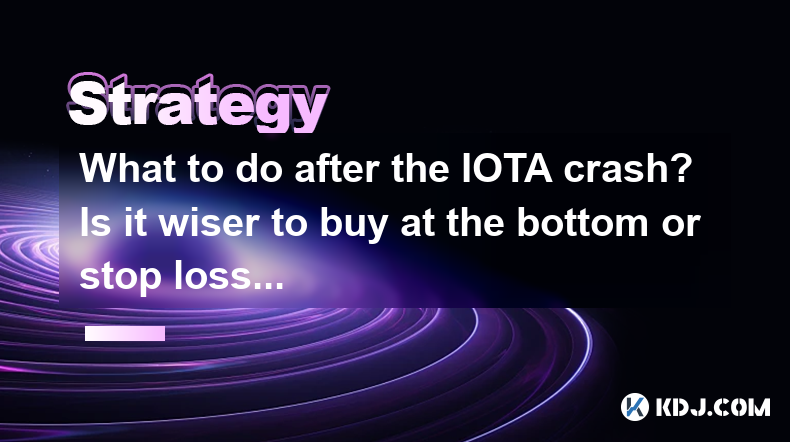-
 bitcoin
bitcoin $115692.075601 USD
5.13% -
 ethereum
ethereum $4162.931611 USD
11.68% -
 bnb
bnb $1310.063287 USD
17.56% -
 tether
tether $1.000983 USD
0.00% -
 xrp
xrp $2.534505 USD
8.16% -
 solana
solana $198.235737 USD
13.49% -
 usd-coin
usd-coin $1.000236 USD
0.02% -
 dogecoin
dogecoin $0.207352 USD
12.89% -
 tron
tron $0.323043 USD
3.62% -
 cardano
cardano $0.701559 USD
11.88% -
 hyperliquid
hyperliquid $39.924597 USD
8.30% -
 chainlink
chainlink $18.934457 USD
11.56% -
 ethena-usde
ethena-usde $1.000552 USD
0.02% -
 stellar
stellar $0.340575 USD
7.05% -
 bitcoin-cash
bitcoin-cash $545.011757 USD
8.86%
What to do after the IOTA crash? Is it wiser to buy at the bottom or stop loss?
After an IOTA crash, investors must weigh the risks and rewards of buying at the bottom against using a stop loss to protect their investments.
May 01, 2025 at 08:43 am

After experiencing a significant crash in the value of IOTA, investors and traders are often left wondering about the best course of action. The decision to buy at the bottom or implement a stop loss can be pivotal, and understanding the nuances of each strategy is essential for making informed decisions. This article delves into the various approaches one can take following an IOTA crash, providing detailed insights into the pros and cons of buying at the bottom versus using a stop loss.
Understanding the IOTA Crash
When IOTA experiences a crash, it is important to first understand the underlying reasons. Market sentiment, regulatory news, and technological updates can all contribute to sudden price drops. By analyzing these factors, you can better gauge whether the crash is a temporary dip or a sign of more significant issues. Keeping abreast of news and market analysis from reputable sources can provide clarity on the situation.
Buying at the Bottom: Pros and Cons
Buying at the bottom refers to purchasing IOTA when its price has reached what you believe to be the lowest point after a crash. This strategy can be lucrative if the price rebounds, but it also carries risks.
Pros of Buying at the Bottom
- Potential for High Returns: If you correctly identify the bottom and the price rebounds, you could see significant gains.
- Long-term Investment Opportunity: Buying at the bottom can be a strategy for long-term holders who believe in the project's future.
- Psychological Satisfaction: There's a sense of achievement in buying low and selling high.
Cons of Buying at the Bottom
- Timing the Market: Accurately predicting the bottom is challenging and often leads to missed opportunities or buying too early.
- Emotional Stress: The fear of further drops can be stressful, leading to panic selling if the price continues to fall.
- Capital Risk: If the price does not recover, your investment could suffer significant losses.
Implementing a Stop Loss: Pros and Cons
Using a stop loss involves setting a predetermined price at which your IOTA will be automatically sold to limit potential losses. This strategy is designed to protect your investment from further declines.
Pros of Using a Stop Loss
- Risk Management: A stop loss helps manage risk by capping potential losses.
- Emotional Detachment: It removes the need to make emotional decisions during volatile market conditions.
- Protection from Further Declines: If the price continues to drop, your losses are minimized.
Cons of Using a Stop Loss
- Missed Opportunities: If the price rebounds after hitting your stop loss, you could miss out on potential gains.
- Slippage: In highly volatile markets, the execution price may be worse than your stop loss price.
- Over-reliance on Automation: Relying too heavily on stop losses can prevent you from making informed decisions based on market conditions.
Factors to Consider Before Deciding
Before choosing between buying at the bottom or using a stop loss, consider the following factors:
- Your Investment Goals: Are you looking for short-term gains or are you a long-term investor?
- Risk Tolerance: How much risk are you willing to take, and how would you feel if your investment decreased further?
- Market Analysis: What do technical and fundamental analyses suggest about IOTA's future price movements?
- Liquidity: How easily can you buy or sell IOTA without significantly impacting its price?
How to Buy at the Bottom
If you decide to buy at the bottom, here are the steps you should follow:
- Monitor Price Trends: Use charting tools to track IOTA's price movements over time. Look for patterns that indicate a potential bottom.
- Set Alerts: Many trading platforms allow you to set price alerts. Use these to notify you when IOTA reaches a certain price level.
- Analyze Volume: High trading volume at a low price can indicate that the bottom is near, as it suggests significant buying interest.
- Stay Informed: Keep up with news and market sentiment. Sudden positive news can cause a rapid rebound.
- Diversify: Don't put all your funds into IOTA. Diversify your investments to mitigate risk.
- Be Patient: Buying at the bottom may require waiting for the right moment. Avoid rushing into a decision.
How to Set Up a Stop Loss
If you opt for a stop loss, follow these steps to set it up effectively:
- Choose a Trading Platform: Ensure your trading platform supports stop loss orders. Popular platforms like Binance and Kraken offer this feature.
- Determine Your Stop Loss Price: Calculate the price at which you want to sell IOTA to limit your losses. This could be a percentage below your purchase price.
- Set the Stop Loss Order: Navigate to the trading interface, select IOTA, and enter your stop loss price. Confirm the order.
- Monitor and Adjust: Regularly review your stop loss price. If IOTA's price moves significantly, you may need to adjust your stop loss to reflect new market conditions.
- Understand the Risks: Be aware of potential slippage and ensure you understand how your platform executes stop loss orders.
Combining Strategies
It's also possible to combine both strategies. For example, you might set a stop loss to protect your investment while also looking for opportunities to buy at the bottom. This approach allows you to manage risk while still taking advantage of potential rebounds.
- Set a Stop Loss: Protect your initial investment by setting a stop loss.
- Monitor for Buying Opportunities: Keep an eye on the market for signs that IOTA has reached a bottom.
- Adjust Your Strategy: Be prepared to adjust your stop loss and buy more IOTA if the market conditions change.
Frequently Asked Questions
Q: Can I use both a stop loss and buy at the bottom simultaneously?A: Yes, you can use both strategies simultaneously. Setting a stop loss can protect your initial investment while you look for opportunities to buy at the bottom. This approach allows you to manage risk while still taking advantage of potential rebounds.
Q: How do I know if IOTA has reached its bottom?A: Identifying the bottom is challenging and involves analyzing price trends, trading volume, and market sentiment. Look for signs of high trading volume at low prices and positive news that could trigger a rebound. However, no method guarantees you'll buy at the exact bottom.
Q: What should I do if IOTA continues to drop after I buy at the bottom?A: If IOTA continues to drop after you buy at the bottom, reassess your investment strategy. Consider setting a stop loss to limit further losses, and continue monitoring market conditions. It's important to stay informed and be prepared to adjust your strategy as needed.
Q: Are there any tools or resources that can help me make better decisions after an IOTA crash?A: Yes, several tools and resources can help. Use charting tools like TradingView for technical analysis, follow cryptocurrency news sites like CoinDesk and CryptoSlate for market updates, and join IOTA community forums for insights from other investors. Additionally, consider using trading bots that can execute stop loss orders automatically.
Disclaimer:info@kdj.com
The information provided is not trading advice. kdj.com does not assume any responsibility for any investments made based on the information provided in this article. Cryptocurrencies are highly volatile and it is highly recommended that you invest with caution after thorough research!
If you believe that the content used on this website infringes your copyright, please contact us immediately (info@kdj.com) and we will delete it promptly.
- XRP Price Prediction: Weekend Rollercoaster or Rally?
- 2025-10-12 08:45:16
- Bittensor (TAO): Super Bullish Signals Point to Potential 2x Rally
- 2025-10-11 10:25:12
- Silver Price Correction: Navigating the Dip & Identifying Key SEO Keywords
- 2025-10-11 10:25:12
- Decoding Crypto Trends: Bittensor's Bull Run, Cardano's Dip, and LivLive's Presale Buzz in 'Uptober 2025'
- 2025-10-12 08:45:16
- MoonBull: The Crypto Meme Coin Promising 1000x Gains?
- 2025-10-11 10:30:01
- Crypto Payroll Revolution: Stablecoins, Altcoins, and the Future of Salary Payments
- 2025-10-11 10:30:01
Related knowledge

Practical parameter settings for a Bitcoin multi-timeframe moving average system
Sep 18,2025 at 10:54pm
Optimizing Timeframe Combinations for Bitcoin Trading1. Selecting appropriate timeframes is crucial when building a multi-timeframe moving average sys...

How can I filter out false breakouts in Dogecoin high-frequency trading?
Sep 22,2025 at 01:00am
Understanding False Breakouts in Dogecoin Trading1. A false breakout occurs when Dogecoin's price appears to move beyond a defined support or resistan...

Techniques for identifying tops and bottoms in the Bitcoin on-chain NVT model
Sep 20,2025 at 07:54pm
Understanding the NVT Model in Bitcoin Analysis1. The Network Value to Transactions (NVT) ratio is often described as the 'P/E ratio' of the cryptocur...

What does the surge in open interest in Bitcoincoin futures mean?
Sep 20,2025 at 11:18pm
Understanding the Surge in Dogecoin Futures Open Interest1. A surge in open interest within Dogecoin futures indicates a growing number of active cont...

How can I use the Ethereum USDT premium to gauge market sentiment?
Sep 18,2025 at 11:55pm
Understanding the Ethereum USDT Premium1. The Ethereum USDT premium refers to the price difference between USDT (Tether) traded on Ethereum-based plat...

What should I do if Ethereum staking yields decline?
Sep 20,2025 at 06:18am
Understanding the Causes Behind Declining Ethereum Staking Yields1. The Ethereum network transitioned to a proof-of-stake consensus mechanism with the...

Practical parameter settings for a Bitcoin multi-timeframe moving average system
Sep 18,2025 at 10:54pm
Optimizing Timeframe Combinations for Bitcoin Trading1. Selecting appropriate timeframes is crucial when building a multi-timeframe moving average sys...

How can I filter out false breakouts in Dogecoin high-frequency trading?
Sep 22,2025 at 01:00am
Understanding False Breakouts in Dogecoin Trading1. A false breakout occurs when Dogecoin's price appears to move beyond a defined support or resistan...

Techniques for identifying tops and bottoms in the Bitcoin on-chain NVT model
Sep 20,2025 at 07:54pm
Understanding the NVT Model in Bitcoin Analysis1. The Network Value to Transactions (NVT) ratio is often described as the 'P/E ratio' of the cryptocur...

What does the surge in open interest in Bitcoincoin futures mean?
Sep 20,2025 at 11:18pm
Understanding the Surge in Dogecoin Futures Open Interest1. A surge in open interest within Dogecoin futures indicates a growing number of active cont...

How can I use the Ethereum USDT premium to gauge market sentiment?
Sep 18,2025 at 11:55pm
Understanding the Ethereum USDT Premium1. The Ethereum USDT premium refers to the price difference between USDT (Tether) traded on Ethereum-based plat...

What should I do if Ethereum staking yields decline?
Sep 20,2025 at 06:18am
Understanding the Causes Behind Declining Ethereum Staking Yields1. The Ethereum network transitioned to a proof-of-stake consensus mechanism with the...
See all articles























![[4K 60fps] Anyway by Retropt (1 Coin) [4K 60fps] Anyway by Retropt (1 Coin)](/uploads/2025/10/13/cryptocurrencies-news/videos/k-fps-retropt-coin/68ec4f42a41d0_image_500_375.webp)


















































